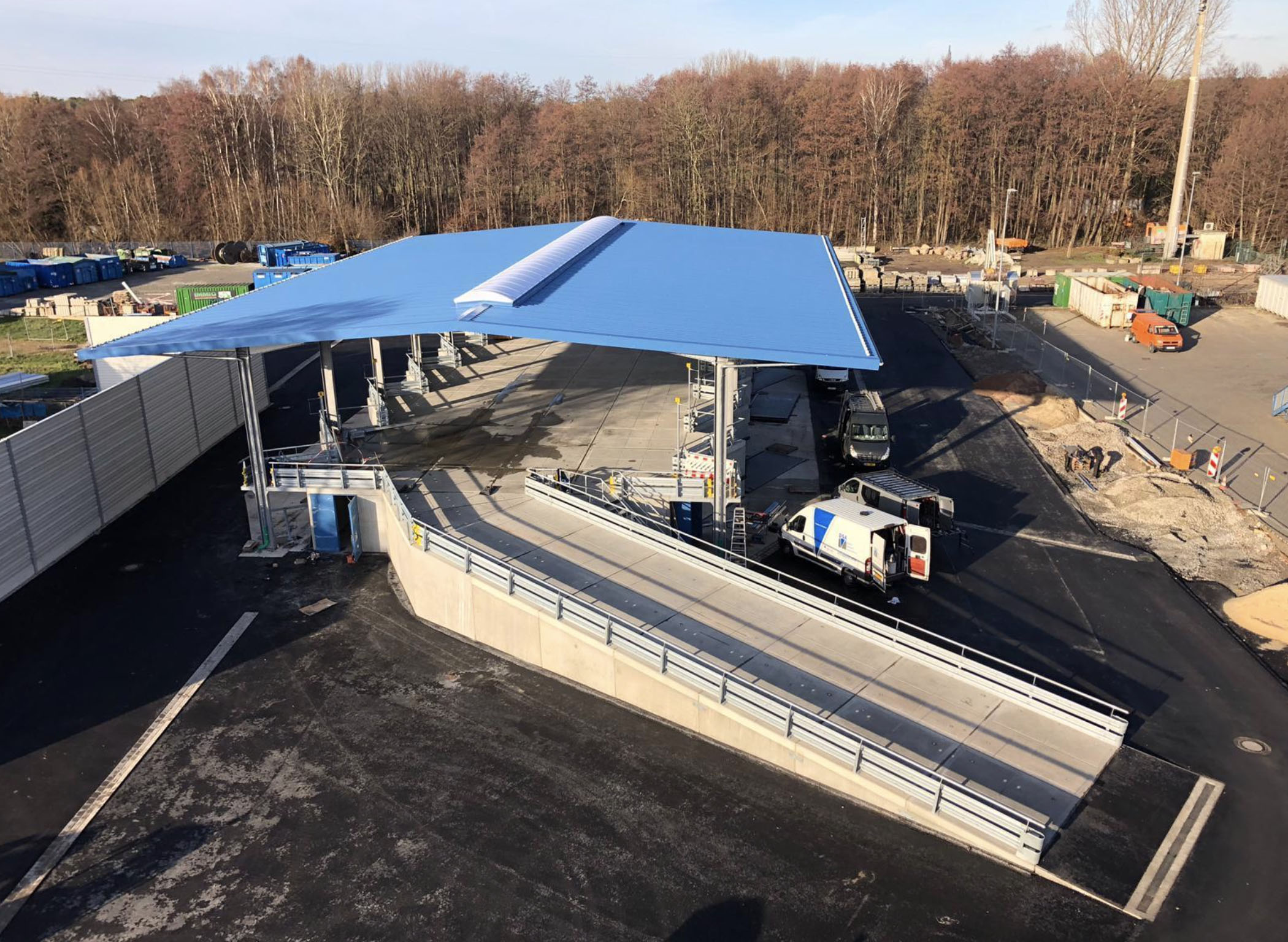Belgian Building Blocks
Ian Dudding visits Belgium to find out more about a range of pre-cast units that are being used in the construction of household waste recycling centres and waste transfer stations
Whilst much attention within the industry is focussed towards the high-profile infrastructure, the humble household waste recycling centre (HWRC) is perhaps on the verge of a quiet revolution. Modulo-béton, based in Belgium, but active in 17 other countries, specialises in producing pre-cast reinforced concrete units for the construction of split-level HWRCs and waste transfer stations.
The modules are to a patented design and are manufactured in each national market, using local materials, and to a large extent are bespoke for each individual project. It is this aspect that allows the modules, and the accessories that are available to complement them, to be tailored to address the needs of individual clients. This flexibility would allow a site to be created that also provides circulation and parking capacity, together with ramps and barriers that are in line with what is commonly expected in the UK.
Of particular importance, perhaps, is that once installed the modules can easily be added to, or indeed moved, giving the individual HWRC an inherent level of “future-proofing”. Finally, once the concrete modules are no longer required, they can be crushed and the materials re-used elsewhere.
Best Practice
It is generally accepted that a “best practice” solution to the construction of HWRCs is to create a split-level arrangement, thus providing the opportunity to physically separate the users tipping at the upper area and site operations at the lower area.
The Modulo-béton units are based on this concept, and it is suggested that on a like-for-like basis, a split-level site created from these modular units is more cost-effective than an equivalent traditional build (ie, cast in-situ reinforced concrete retaining walls with backfill). That assumption has yet to be fully tested in the UK market, however, experience from a large number of projects on the continent (in excess of 200 to date) has shown that another potentially important benefit is the speed with which such a site can be constructed. Once the groundworks are complete (eg a levelled/surfaced site), the absence of them having sub-surface foundations means the modular units can feasibly be delivered and installed within a matter of days. Alternatively, in the case of an existing HWRC to be refurbished, they offer a comparatively rapid solution to converting an existing at-grade site to split-level. In either case this could be a significant advantage if, for example, the alternative is to have an existing site out of action for several months, meaning a prolonged reduction in local HWRC capacity and material capture rates.
The modules can be produced in heights of between 900mm and 2 800mm. Units in excess of around 2 000mm in height provide another potential benefit for HWRC site owners and operators in that the void created below the deck can be used for additional material or equipment storage or workshops. The decks of the units are typically 3 000mm x 3 000mm; as these can be safely transported on the highway without a police escort, however narrower (from 1 000mm) or wider (up to 4 000mm) deck dimensions can also be created if required. Decks can also be specified to support between 3.5 and 29 tonnes.
A recent visit to the newly built HWRC in Dilbeek, near Brussels in Belgium, offered a good example of a site constructed with Modulo-béton units, unusually located underneath a motorway bridge.
In the Flemish area of Belgium residents pay for the deposit of non-recyclable materials. Users are required to swipe an identity card on entry to the site – if only recyclables are to be deposited then free access is granted to the recycling zone (in this case the recycling zone is a simple arrangement of roll-on-off containers with steel staircases). If non-recyclable/heavy materials are to be deposited then users are required to access a separate zone, after passing over a weighbridge, and the calculated charge being debited from their account.
This zone is a split-level arrangement formed of Modulo-béton units, with a fairly steep ramp up and off. Materials such as green waste, panes of glass, soil and hardcore, and bulky waste are all deposited from the upper area into dedicated containers below. The raised deck was 2 200mm high and made of units 3 000mm x 4 000mm. Underneath the deck the owner had opted to take advantage of the storage opportunities and part of the void space was used for the storage of pallets of plastic refuse sacks, while another section housed mini-sweepers, and a final section had been converted to a workshop (fully lit and ventilated).
There are a range of security doors that can be fitted, so, in the UK, for example, these void spaces could feasibly be used to house WEEE, fluorescent tubes or many of the other fractions of materials that are collected at typical HWRCs (or indeed packaged bags of compost, that are increasingly being made available for sale at some HWRC sites). In addition, this site also utilised the purpose-built, stand alone Modulo-béton storage modules, in this case a double-bunded store for hazardous liquids/paints.
By utilising the pre-cast Modulo-béton units, this new HWRC was constructed within three days of completion of the groundworks (levelling of site, installation of drainage and surfacing), which was a major advantage in ensuring that the site was operational as soon as possible.
Modulo-béton will has recently constructed its first modular HWRC in the UK, and it is hoped that, in due course, these modules will be able to offer an added measure of innovation and flexibility to the national HWRC network.



